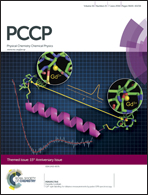Nanoporous molybdenum carbide wires as an active electrocatalyst towards the oxygen reduction reaction
Abstract
A non-precious metal electrocatalyst has been developed for the oxygen reduction reaction based on nanoporous molybdenum carbide (nano-Mo2C) wires through a facile calcination of sub-nanometer periodic organic–inorganic hybrid nanowires. The highly dispersed Mo2C wires were composed of 10–15 nm nanocrystals with a mesopore size of 3.3 nm. The properties of nano-Mo2C wires were characterized using scanning electron microscopy, transmission electron microscopy, X-ray diffraction and N2 adsorption/desorption porosimetry. The highly active surface area and enriched nanoporosity for nano-Mo2C wires are unique features that make them a high-performance electrocatalyst for oxygen reduction in an alkaline medium. The electrocatalysis and reaction kinetics results show that nano-Mo2C-based materials can be developed as new catalysts with high activity at low cost for electrochemical energy conversion applications.

- This article is part of the themed collection: PCCP’s 15th anniversary

 Please wait while we load your content...
Please wait while we load your content...